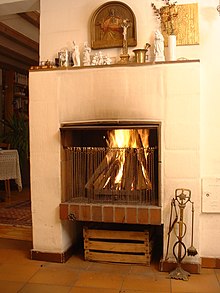**Types of Fireplaces**:
– Manufactured fireplaces made with sheet metal or glass fire boxes
– Electric fireplaces as built-in replacements for wood or gas or retrofit with log inserts or electric fireboxes
– Wall mounted electric fireplaces, electric fireplace stoves, electric mantel fireplaces, and fixed or free standing electric fireplaces
– Masonry and prefabricated fireplaces fueled by various sources like wood, charcoal, coal, and ethanol
– Ventless fireplaces fueled by gel, liquid propane, bottled gas, or natural gas; subject to laws in some states
**Fireplace Accessories**:
– Grates, fireguards, log boxes, andirons, pellet baskets for fuel and combustion acceleration
– Heavy metal firebacks for heat reflection and decoration
– Fenders, fireplace tools (pokers, bellows, tongs, shovels, brushes), and tool stands
– Additional accessories like log baskets, companion sets, coal buckets, and cabinet accessories
**History and Evolution of Fireplaces**:
– Evolution from ancient fire pits to raised hearths and chimneys for better ventilation
– Shift in fireplace design from necessity to visual interest over time
– Impact of Industrial Revolution and design movements like Arts and Crafts on fireplace aesthetics
**Heating Efficiency**:
– Methods to increase fireplace efficiency like incorporating blowers and firebacks
– Modern wood-burning masonry fireplaces with high efficiency ratings
– Special fireboxes for cleaner burning and higher heating efficiencies
**Health and Environmental Impact**:
– Health effects of prolonged wood smoke inhalation, especially on respiratory systems
– Risks associated with burning gases like propane, butane, and methane, and ethanol fires
– Environmental effects of burning hydrocarbon fuels on air pollution and climate change
A fireplace or hearth is a structure made of brick, stone or metal designed to contain a fire. Fireplaces are used for the relaxing ambiance they create and for heating a room. Modern fireplaces vary in heat efficiency, depending on the design.


Historically, they were used for heating a dwelling, cooking, and heating water for laundry and domestic uses. A fire is contained in a firebox or fire pit; a chimney or other flue allows exhaust gas to escape. A fireplace may have the following: a foundation, a hearth, a firebox, a mantel, a chimney crane (used in kitchen and laundry fireplaces), a grate, a lintel, a lintel bar, an overmantel, a damper, a smoke chamber, a throat, a flue, and a chimney filter or afterburner.
On the exterior, there is often a corbelled brick crown, in which the projecting courses of brick act as a drip course to keep rainwater from running down the exterior walls. A cap, hood, or shroud serves to keep rainwater out of the exterior of the chimney; rain in the chimney is a much greater problem in chimneys lined with impervious flue tiles or metal liners than with the traditional masonry chimney, which soaks up all but the most violent rain. Some chimneys have a spark arrestor incorporated into the crown or cap.
Organizations like the United States Environmental Protection Agency (EPA) and the Washington State Department of Ecology warn that, according to various studies, fireplaces can pose health risks. The EPA writes "Smoke may smell good, but it's not good for you."
Definition from ChatGPT:
Fireplace:
A fireplace is a structure typically made of brick, stone, or metal that is designed to contain a fire for heating and ambiance. It is usually found in a living room or family room and may be used for heating, cooking, or simply for decorative purposes.